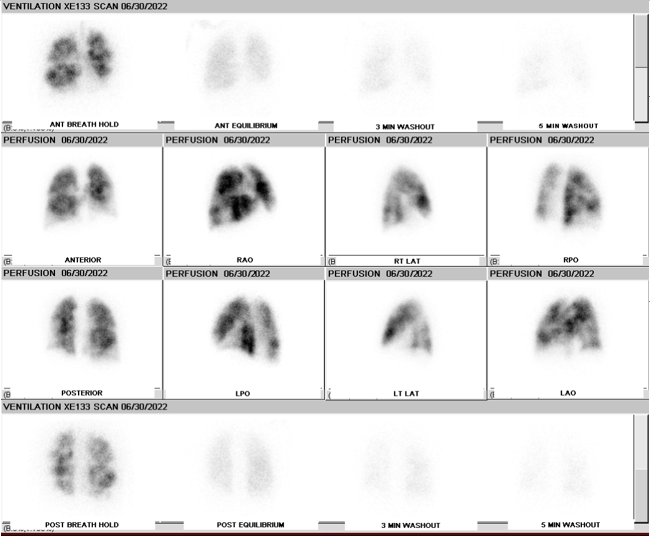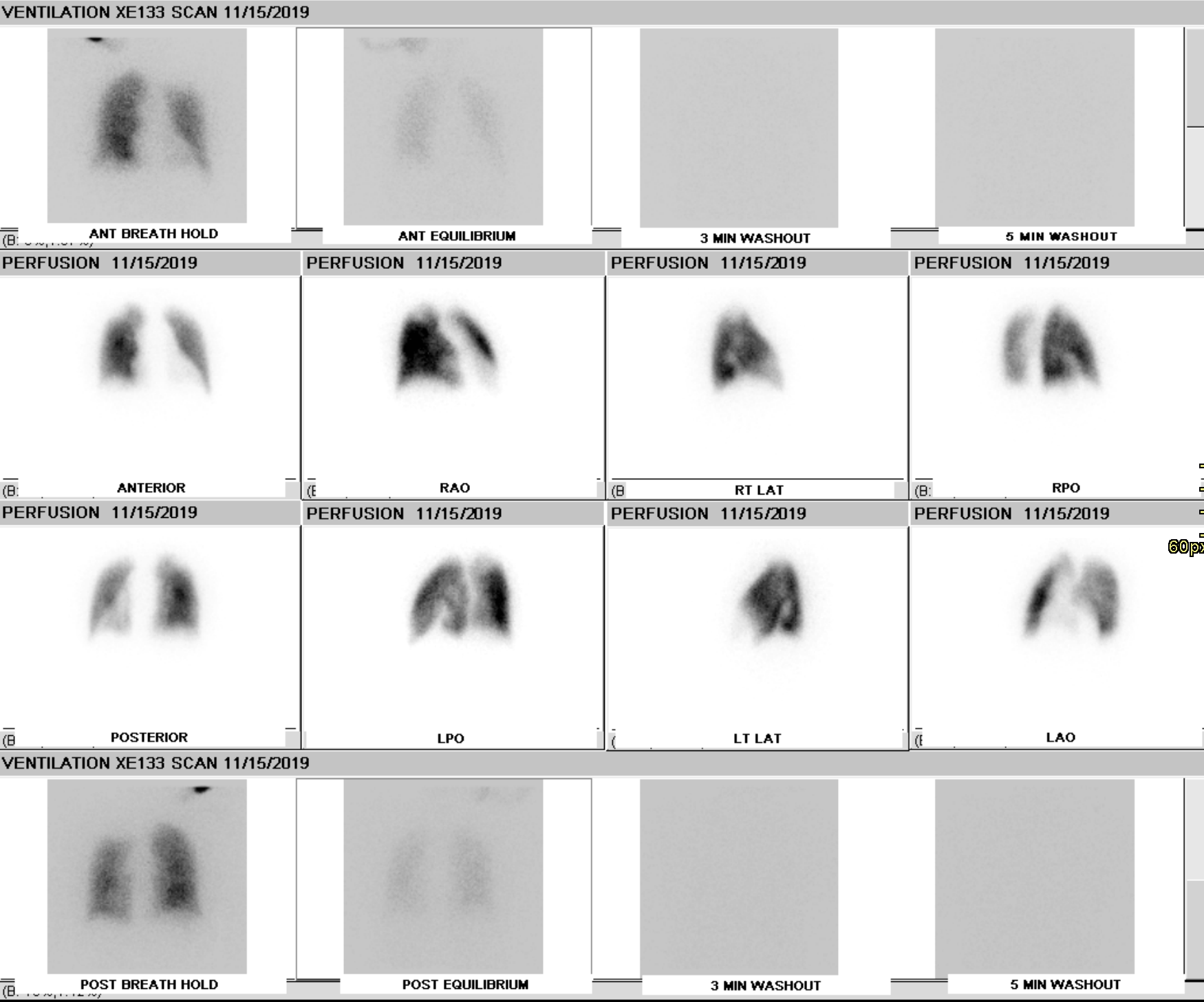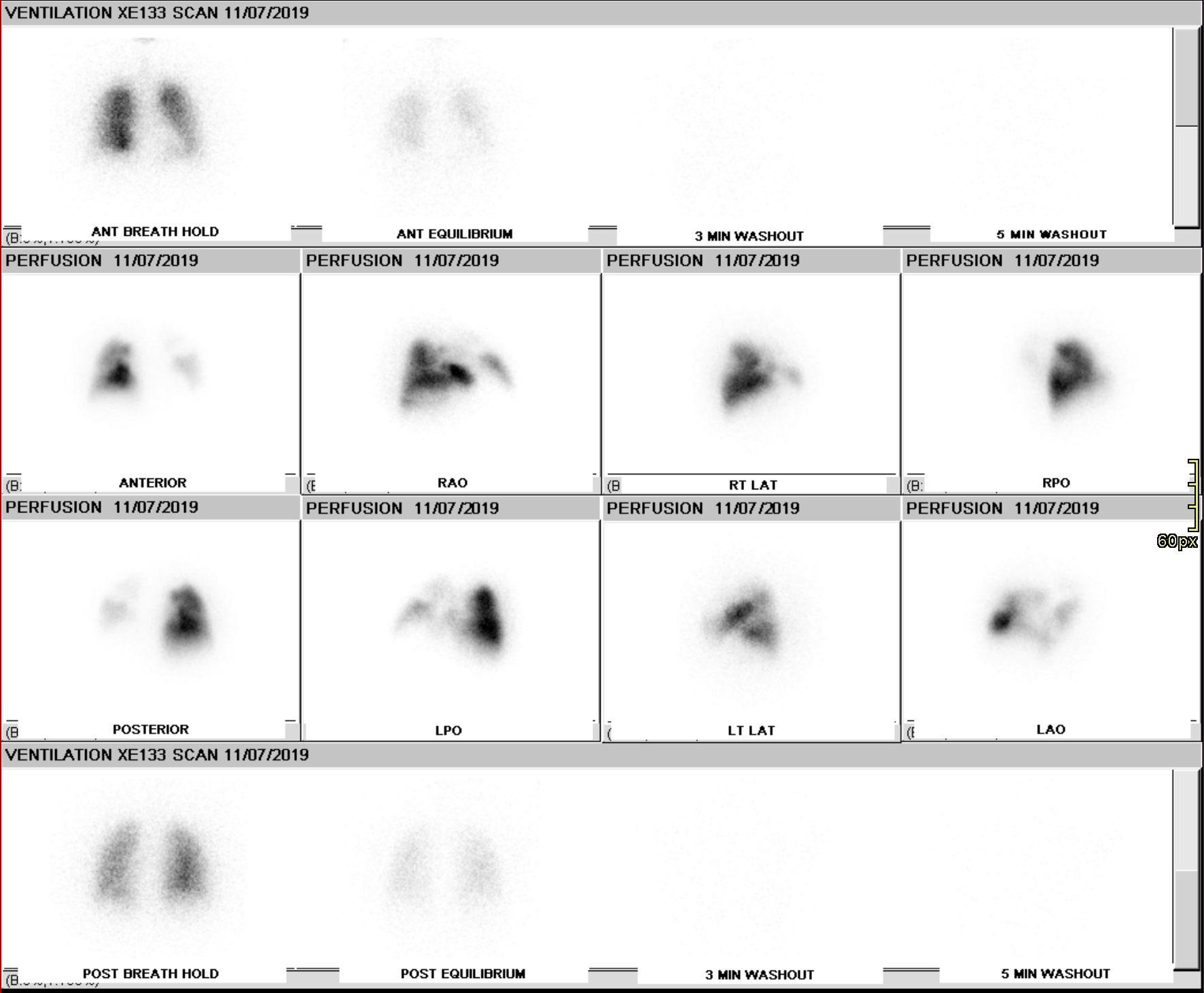[1]
QUINN JL 3rd,WHITLEY JE,HUDSPETH AS,PRICHARD RW, EARLY CLINICAL APPLICATIONS OF LUNG SCINTISCANNING. Radiology. 1964 Feb;
[PubMed PMID: 14118400]
[2]
Moore AJE,Wachsmann J,Chamarthy MR,Panjikaran L,Tanabe Y,Rajiah P, Imaging of acute pulmonary embolism: an update. Cardiovascular diagnosis and therapy. 2018 Jun;
[PubMed PMID: 30057872]
[3]
Derenoncourt PR,Felder GJ,Royal HD,Bhalla S,Lang JA,Matesan MC,Itani M, Ventilation-Perfusion Scan: A Primer for Practicing Radiologists. Radiographics : a review publication of the Radiological Society of North America, Inc. 2021 Nov-Dec
[PubMed PMID: 34678101]
[4]
Parker JA,Coleman RE,Grady E,Royal HD,Siegel BA,Stabin MG,Sostman HD,Hilson AJ, SNM practice guideline for lung scintigraphy 4.0. Journal of nuclear medicine technology. 2012 Mar;
[PubMed PMID: 22282651]
Level 1 (high-level) evidence
[5]
Magnant J,Vecellio L,de Monte M,Grimbert D,Valat C,Boissinot E,Guilloteau D,Lemarié E,Diot P, Comparative analysis of different scintigraphic approaches to assess pulmonary ventilation. Journal of aerosol medicine : the official journal of the International Society for Aerosols in Medicine. 2006 Summer
[PubMed PMID: 16796539]
Level 2 (mid-level) evidence
[6]
Metter D,Tulchinsky M,Freeman LM, Current Status of Ventilation-Perfusion Scintigraphy for Suspected Pulmonary Embolism. AJR. American journal of roentgenology. 2017 Mar;
[PubMed PMID: 28095020]
[7]
Meignan MA, Lung ventilation/perfusion SPECT: the right technique for hard times. Journal of nuclear medicine : official publication, Society of Nuclear Medicine. 2002 May
[PubMed PMID: 11994529]
[8]
Roach PJ,Schembri GP,Bailey DL, V/Q scanning using SPECT and SPECT/CT. Journal of nuclear medicine : official publication, Society of Nuclear Medicine. 2013 Sep
[PubMed PMID: 23907760]
[9]
Stein PD,Freeman LM,Sostman HD,Goodman LR,Woodard PK,Naidich DP,Gottschalk A,Bailey DL,Matta F,Yaekoub AY,Hales CA,Hull RD,Leeper KV Jr,Tapson VF,Weg JG, SPECT in acute pulmonary embolism. Journal of nuclear medicine : official publication, Society of Nuclear Medicine. 2009 Dec;
[PubMed PMID: 19949025]
[10]
Bajc M,Olsson B,Palmer J,Jonson B, Ventilation/Perfusion SPECT for diagnostics of pulmonary embolism in clinical practice. Journal of internal medicine. 2008 Oct
[PubMed PMID: 18823506]
[11]
Leblanc M,Leveillée F,Turcotte E, Prospective evaluation of the negative predictive value of V/Q SPECT using 99mTc-Technegas. Nuclear medicine communications. 2007 Aug
[PubMed PMID: 17625390]
[12]
Gutte H,Mortensen J,Jensen CV,Johnbeck CB,von der Recke P,Petersen CL,Kjaergaard J,Kristoffersen US,Kjaer A, Detection of pulmonary embolism with combined ventilation-perfusion SPECT and low-dose CT: head-to-head comparison with multidetector CT angiography. Journal of nuclear medicine : official publication, Society of Nuclear Medicine. 2009 Dec
[PubMed PMID: 19910421]
[13]
Pinho DF,Banga A,Torres F,Mathews D, Ventilation perfusion pulmonary scintigraphy in the evaluation of pre-and post-lung transplant patients. Transplantation reviews (Orlando, Fla.). 2019 Apr;
[PubMed PMID: 30415913]
[14]
Value of the ventilation/perfusion scan in acute pulmonary embolism. Results of the prospective investigation of pulmonary embolism diagnosis (PIOPED). JAMA. 1990 May 23-30;
[PubMed PMID: 2332918]
[15]
Sostman HD,Miniati M,Gottschalk A,Matta F,Stein PD,Pistolesi M, Sensitivity and specificity of perfusion scintigraphy combined with chest radiography for acute pulmonary embolism in PIOPED II. Journal of nuclear medicine : official publication, Society of Nuclear Medicine. 2008 Nov
[PubMed PMID: 18927339]
[16]
Miniati M,Pistolesi M,Marini C,Di Ricco G,Formichi B,Prediletto R,Allescia G,Tonelli L,Sostman HD,Giuntini C, Value of perfusion lung scan in the diagnosis of pulmonary embolism: results of the Prospective Investigative Study of Acute Pulmonary Embolism Diagnosis (PISA-PED). American journal of respiratory and critical care medicine. 1996 Nov
[PubMed PMID: 8912753]
[17]
Sostman HD,Stein PD,Gottschalk A,Matta F,Hull R,Goodman L, Acute pulmonary embolism: sensitivity and specificity of ventilation-perfusion scintigraphy in PIOPED II study. Radiology. 2008 Mar
[PubMed PMID: 18195380]
[18]
van Agteren JE, Carson KV, Tiong LU, Smith BJ. Lung volume reduction surgery for diffuse emphysema. The Cochrane database of systematic reviews. 2016 Oct 14:10(10):CD001001
[PubMed PMID: 27739074]
Level 1 (high-level) evidence
[19]
Martini K,Frauenfelder T, Emphysema and lung volume reduction: the role of radiology. Journal of thoracic disease. 2018 Aug;
[PubMed PMID: 30210824]
[20]
Colice GL,Shafazand S,Griffin JP,Keenan R,Bolliger CT,American College of Chest Physicians, Physiologic evaluation of the patient with lung cancer being considered for resectional surgery: ACCP evidenced-based clinical practice guidelines (2nd edition). Chest. 2007 Sep
[PubMed PMID: 17873167]
Level 1 (high-level) evidence
[21]
Yuan ST,Frey KA,Gross MD,Hayman JA,Arenberg D,Curtis JL,Cai XW,Ramnath N,Kalemkerian GP,Ten Haken RK,Eisbruch A,Kong FM, Semiquantification and classification of local pulmonary function by V/Q single photon emission computed tomography in patients with non-small cell lung cancer: potential indication for radiotherapy planning. Journal of thoracic oncology : official publication of the International Association for the Study of Lung Cancer. 2011 Jan
[PubMed PMID: 21119546]
[22]
Meng X,Frey K,Matuszak M,Paul S,Ten Haken R,Yu J,Kong FM, Changes in functional lung regions during the course of radiation therapy and their potential impact on lung dosimetry for non-small cell lung cancer. International journal of radiation oncology, biology, physics. 2014 May 1
[PubMed PMID: 24725697]
[23]
Pengo V, Lensing AW, Prins MH, Marchiori A, Davidson BL, Tiozzo F, Albanese P, Biasiolo A, Pegoraro C, Iliceto S, Prandoni P, Thromboembolic Pulmonary Hypertension Study Group. Incidence of chronic thromboembolic pulmonary hypertension after pulmonary embolism. The New England journal of medicine. 2004 May 27:350(22):2257-64
[PubMed PMID: 15163775]
[24]
Tunariu N, Gibbs SJ, Win Z, Gin-Sing W, Graham A, Gishen P, Al-Nahhas A. Ventilation-perfusion scintigraphy is more sensitive than multidetector CTPA in detecting chronic thromboembolic pulmonary disease as a treatable cause of pulmonary hypertension. Journal of nuclear medicine : official publication, Society of Nuclear Medicine. 2007 May:48(5):680-4
[PubMed PMID: 17475953]
[25]
Dong C, Zhou M, Liu D, Long X, Guo T, Kong X. Diagnostic accuracy of computed tomography for chronic thromboembolic pulmonary hypertension: a systematic review and meta-analysis. PloS one. 2015:10(4):e0126985. doi: 10.1371/journal.pone.0126985. Epub 2015 Apr 29
[PubMed PMID: 25923810]
Level 1 (high-level) evidence
[26]
Soler X,Kerr KM,Marsh JJ,Renner JW,Hoh CK,Test VJ,Morris TA, Pilot study comparing SPECT perfusion scintigraphy with CT pulmonary angiography in chronic thromboembolic pulmonary hypertension. Respirology (Carlton, Vic.). 2012 Jan;
[PubMed PMID: 21899658]
Level 3 (low-level) evidence
[27]
Lutzker LG,Perez LA, Radioactive embolization from upper-extremity thrombophlebitis. Journal of nuclear medicine : official publication, Society of Nuclear Medicine. 1975 Mar;
[PubMed PMID: 1113175]
[28]
Waxman AD,Bajc M,Brown M,Fahey FH,Freeman LM,Haramati LB,Julien P,Le Gal G,Neilly B,Rabin J,Soudry G,Tapson V,Torbati S,Kauffman J,Ahuja S,Donohoe K, Appropriate Use Criteria for Ventilation-Perfusion Imaging in Pulmonary Embolism: Summary and Excerpts. Journal of nuclear medicine : official publication, Society of Nuclear Medicine. 2017 May;
[PubMed PMID: 28461589]



